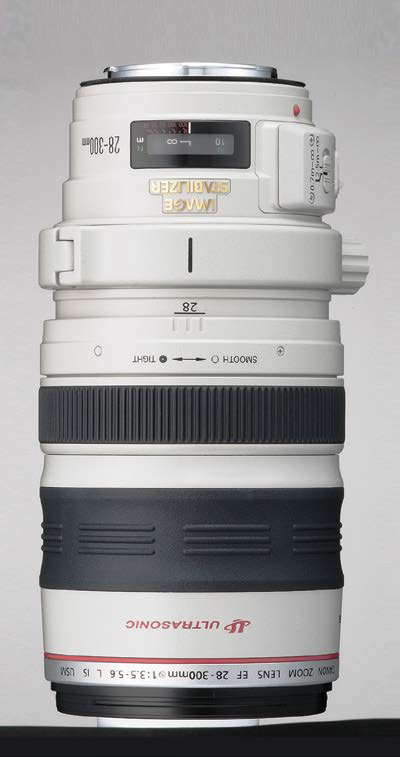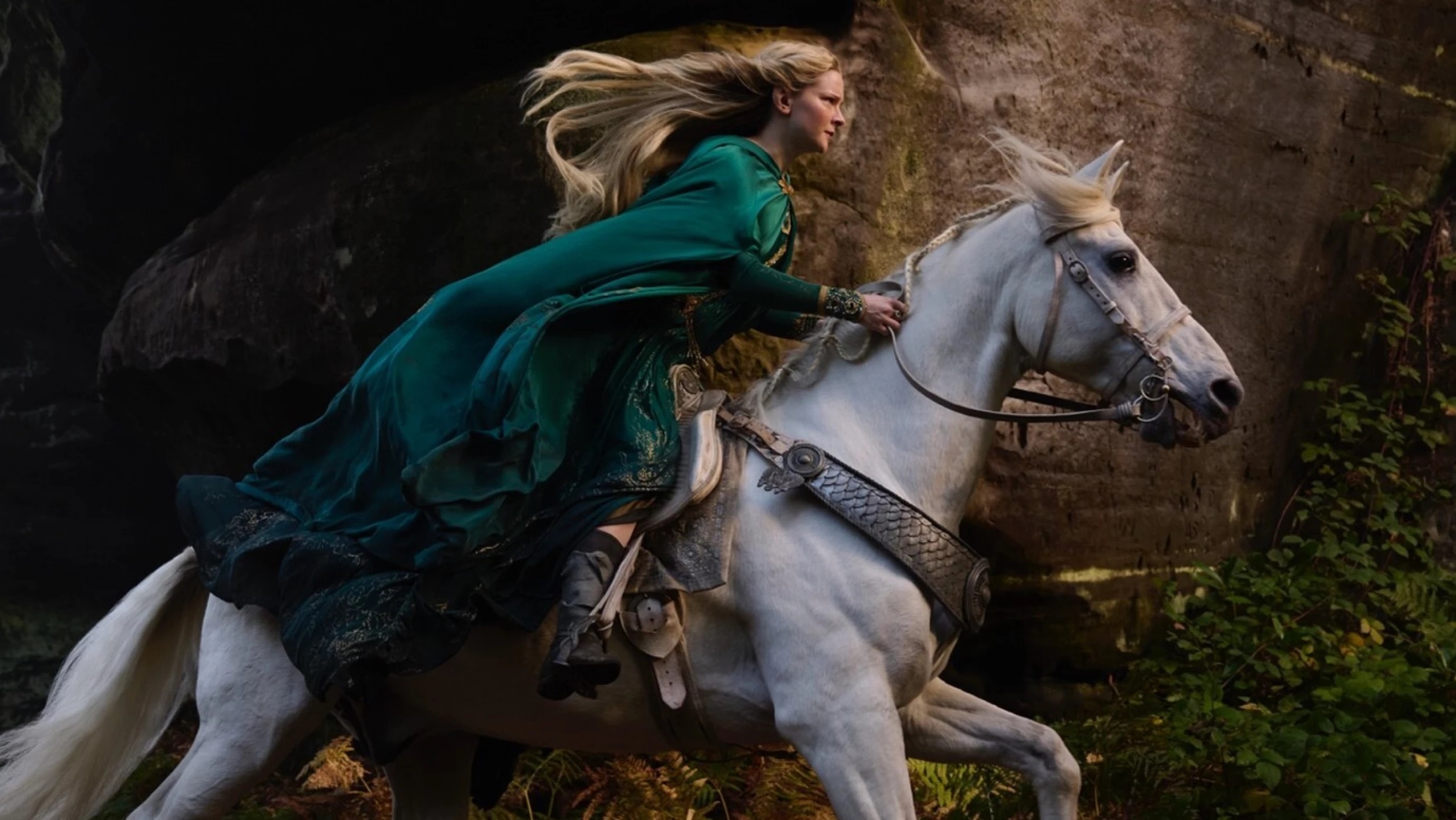Canon’s EF 28-300 mm USM L IS Lens

The Canon EF 28-300 mm f3.5-5.6 USM L IS Lens
There are multiple sets of prime lenses now available for use with DSLRs and large sensor digital cine cameras at various price points. However, the selection of multipurpose “pro zoom” lenses that could be called affordable is somewhat restricted. If you add another criterion—a zoom ratio of more than four or five, then that list shrinks to less than a handful—selling for any price.
There is one EF mount lens, however, which combines an impressive focal range—especially on the telephoto end— but is still wide enough to serve as a general- purpose lens, especially with a full sensor camera, such as Canon’s 5D.
As you might have guessed, this lens was designed for use in still photo applications; however, budget-minded directors of photography haven’t let that become a deal breaker ever since the DSLR/ large sensor revolution revealed a paucity of bona fide cine zoom lenses available at any price, let alone below the $5,000 mark. Canon’s EF 28 to 300 mm f/3.5-5.6 USM L IS lens is a notable exception and this is why I had to try it out.
FEATURES
The EF 28-300 mm f3.5-5.6L IS USM Lens features an exceptional zoom ratio (nearly 11x), making it useful for a broad range of applications including sports, nature, documentaries, TV commercials and general purpose EFP, and even ENG shooting. Moreover, this lens is equipped with a dual-mode image stabilizer optimized either for moving or static shots.
The EF lens feels heftier than its official 3.7 pounds, thanks partly to all of the L series Pro glass it contains. There are a total of 23 elements in 16 groups, including three UD and two aspherical elements for aberration correction and for optimal optical performance throughout its focal range. The lens also may have the longest zoom ratio of any optic not expressly made for video capture. It’s impressive too in that you can focus down to 2.3 feet throughout the zoom range for eye-popping closeups, especially at the longer focal lengths.
This large lens is also reasonably light sensitive too, opening to f3.5 at 28 mm. and f5.6 at 300 mm.
In the video mode, the exposure can be adjusted manually or automatically, although for maximum exposure control it should be adjusted manually to expose for highlights, shadows or for something that lies in-between.
The lens uses a push-pull zoom mechanism, meaning that the focal length increases as you stretch the barrel forwards, and decreases as you compress it. A metal collar next to the manual focus ring lets you tighten or loosen the tension on the barrel.
As this lens was made for still photography it really wasn’t designed to zoom smoothly; however, with the tension level set low enough, smooth short zooms are quite doable with a little practice and patience. (When the tension is set to “max,” the lens becomes a fixed focal length device.)
It includes several useful features not typically found on cine lenses such as full-time manual autofocus override, an ultrasonic autofocus and a focus range-limiting function. There are two autofocus range options: seven meters to infinity and two-and-a-half meters to infinity. (The latter is ideal when shooting through such things as glass, fencing or light foliage.) This optic also has special coatings to minimize ghosting and flare and to resist dust, moisture and even water droplets, making it ideal for outdoor use in less than perfect conditions. The front element takes standard 77 mm filters for extra protection.
The lens is also fairly user-friendly, particularly for those who are familiar with Canon’s EF lens series. Another feature worthy of note is Canon’s Image Stabilization (IS) system. According to the company, when using IS in still photography you can handhold at three f-stops less than with a non-IS lens.
For video applications, “level 2,” which is optimized for panning, should be the default mode. The 28-300’s IS is also tripod- sensing, hence stabilization should be on when using a tripod in order to minimize vibrations.
IN USE
I tested the lens with two Canon DSLRs—the EOS 60D and a more compact Rebel XTI. With its blond barrel, black rubber adjusting rings and basic design and proportions, the 28-300 looked strikingly like my own long EF lens, the EF100-400 mm, although a bit heavier in hand.
I relaxed the “tension” on the barrel so that I could zoom in and out as smoothly and quickly as possible. I also wanted to attempt some short zooms with the review lens, even though it wasn’t designed the way most variable focal length cine and video lenses are. I quickly found out that the key to this was in keeping the tension level set low, but with just enough resistance to moderate the zoom speed. This did require some amount of trial and error adjusting, and the really frustrating thing was that I had to keep retweaking as the tension ring often locked up with the focus ring, losing its sweet spot. However, repeated adjusting usually solved the problem.
Fortunately, the len’s ultrasonic autofocus function integrates seamlessly with the 60D, including manual override. If you don’t like what you get with autofocus you move things manually. The autofocus isn’t flawless, particularly in shadows where depth of field is shallow. This can trigger a hunting behavior and result in variable soft focus, so it’s nice to be able to revert to manual mode.
Ergonomically, the AF switches and stabilizer switches are recessed and “sticky,” so they can’t be changed inadvertently while shooting. They’re also clustered together, close to the camera for easy access while shooting. However the switches are all identical to the touch, so switching while shooting is ill advised.
A great example of the utility of using both AF and manual override occurred when I was shooting deer in a woodland area at dusk with the Canon Series III 1.4X extender that reduced the maximum aperture to f8 in the 200–300 mm range. Hence, depth of field was very shallow and the AF sometimes keyed on trees and branches rather than on the deer, especially when they didn’t fill the frame. On the other hand, the extender made it much easier to nearly fill the frame with deer, allowing only immediately adjacent foliage to affect the autofocus. I quickly compensated for this by tweaking focus manually and got instant confirmation by the greening of the 60 D’s white focusing rectangle (which can be moved within the frame to sharpen focus wherever needed). This dual-focus mode allowed me to concentrate on my framing and special camera moves and also on capturing any interesting behavior from my subject. There was no need to obsess on focusing, even in fading light conditions.
It’s worth noting too that the 60D, and Rebel XTi cameras both lack full-frame sensors. This results in a 1.6x crop factor with even less of the softer outer perimeter of the lens being involved in the image capture and most of the action taking place in the sharpest center core portion of the glass. This enabled me to primarily use the best parts of the high-quality L series optical elements to achieve maximum sharpness.
Even when wide open at f5.6 corners remained quite sharp through most of the high end of the focal range. Edge sharpness was even better in partial sunlight, allowing me to stop down one or two more stops especially when maxing out at the longer focal length.
Naturally, the results in bright sunlight were even better—even with extenders— when maxed out between 200 and 300 mm. The key was always staying in focus by manually tweaking when needed.
Despite warnings, I really didn’t notice any vignetting, although truthfully I wasn’t shooting the sort of subjects that typically triggers it; however, I have to admit that I really didn’t really try to hard to push that envelope.
I also didn’t encounter any problems with the len’s image stabilization system. I always kept it on, mostly on “level 2” for vibration-free panning and tilting. According to Canon, it’s important to keep stabilization on even when shooting from a tripod, as this lens senses tripods, even when vibrations are minimal. Keeping image stabilization on when using the lens on a tripod is also recommended to take full advantage of the secondary stabilization mode, thereby reducing shutter, handling and wind vibrations.
I also briefly tested the 28-300 on a 1/3- inch CCD camera, the Canon XL H1 via a Canon mounting adaptor, which probably doubled the 1.6x (APS-C) DSLR crop factor. Whatever the de facto crop was, I could still fill the frame with a stationary snowy owl 120 feet away with perfect sharpness. I got a decent depth of field and color rendition in the full sunlight. The footage also intercut seamlessly with that from the Canon 20X video lens with a 1.5x tele-extender from 16X9. I didn’t have any issues with the stabilization system being off; although I was mostly locked down in this mode due to the difficulty in counterbalancing this front-heavy lens.
SUMMARY
By itself, the EF 28-300 mm is a versatile, well-designed rugged lens with excellent optics and internal stabilization for use with DSLRs and large sensor digital cine cameras, and with some broadcast cameras via adaptors. Due to its broad focal range (10.7x), it can fill many production niches, especially for action use in sports and wildlife thanks to features such as manual override autofocus, two-stage internal stabilization and dual-range autofocus.
Despite warnings to the contrary, this lens can be used with Canon series III tele-extenders to take its nearly 11x zoom to an impressive 600 mm, although it’s not recommend for work at the full 600 mm zoomed focal length. Combined with an additional crop factor of 1.6x with most non-full frame sensors, this yields a powerful lens equivalent to nearly 1000 mm on a 35mm SLR camera, which is ideal for many applications where telephoto power is key.
Carl Mrozek operates Eagle Eye Media, and specializes in wildlife and outdoor subjects. His work regularly appears on the Discovery Channel, The Weather Channel, CBS, PBS and other networks. Contact him ateagleye11@gmail.com.
FAST FACTS
APPLICATION
EFP: TV & Film production with DSLRs and large sensor digital cine cameras, TV commercials, documentaries, especially wildlife and sports corporate and events
KEY FEATURES
Broad focal range, selectable focus range, manual autofocus override, dual stage internal stabilization, removable tripod collar, low chromatic aberration, rugged
PRICE
$ 2,689
CONTACT
Canon
800-652-2666
www.usa.canon.com
Get the TV Tech Newsletter
The professional video industry's #1 source for news, trends and product and tech information. Sign up below.
